Module 19 - C101
C101: Introduction to Communications Protocols and Their Uses in ITS Applications
HTML of the PowerPoint Presentation
(Note: This document has been converted from a PowerPoint presentation to 508-compliant HTML. The formatting has been adjusted for 508 compliance, but all the original text content is included, plus additional text descriptions for the images, photos and/or diagrams have been provided below.)
Slide 1:
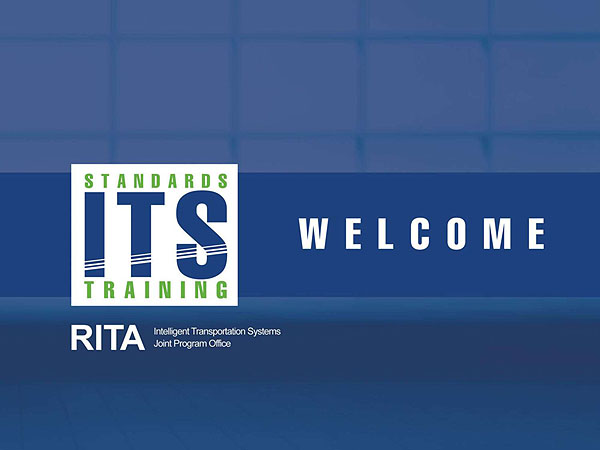
(Extended Text Description: Slide 1: Welcome - Graphic image of introductory slide. A large dark blue rectangle with a wide, light grid pattern at the top half and bands of dark and lighter blue bands below. There is a white square ITS logo box with words “Standards ITS Training” in green and blue on the middle left side. The word “Welcome” in white is to the right of the logo. Under the logo box are the words “RITA Intelligent Transportation Systems Joint Program Office.”)
Slide 2:
C101: Introduction to Communications Protocols and Their Uses in ITS Applications
Slide 3:

Slide 4:
Instructor

Raman K. Patel, Ph.D., P.E.
President
RK Patel Associates, Inc. New York, NY, USA
Slide 5:
Target Audience
- Telecommunications, system administration, and network management staff
- Engineering staff
- System engineers, developers, and implementers
- Traffic management and operations staff
Slide 6:
Recommended Prerequisite(s)
- I101: Using ITS Standards: An Overview
- A101: Introduction to Acquiring Standards-based ITS Systems
Slide 7:
Curriculum Path (Non-SEP)
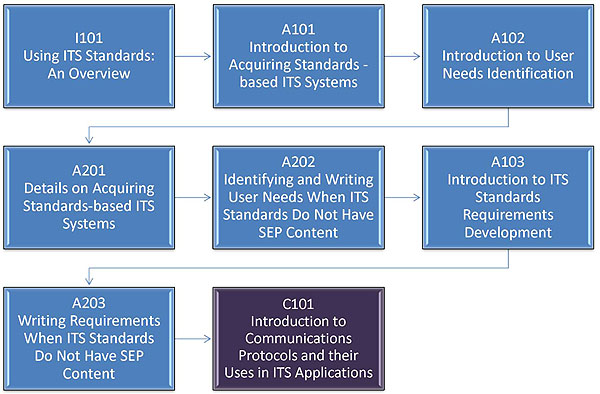
(Extended Text Description: A graphical illustration indicating the sequence of training modules for the standards that include Systems Engineering Process content. Each module is represented by a box with the name of the module in it and an arrow showing the logical flow of the modules and the current module highlighted. The first box is labeled “I101 Using ITS Standards: An Overview.” An arrow from this box connects it to a highlighted box labeled “A101 Introduction to Acquiring Standards-based ITS Systems,” representing this module. An arrow from this box connects it to a box labeled “A102 Introduction to User Needs Identification.” An arrow from this box connects it to a box located at the start of the next line labeled “A201 Details on Acquiring Standards-based ITS Systems.” An arrow from this box connects it to a box labeled “A202 Understanding and Writing User Needs when ITS Standards Do Not Have SEP Content. An arrow from this box connects to A103 “A103 Introduction to ITS Standards Requirements Development.” An arrow from this box connects to “A203 Writing Requirements When ITS Standards Do Not Have SEP Content” and a final arrow connects to last box labeled as “C101 Introduction to Communications Protocols and their Uses in ITS Applications.” )
Slide 8:
Curriculum Path
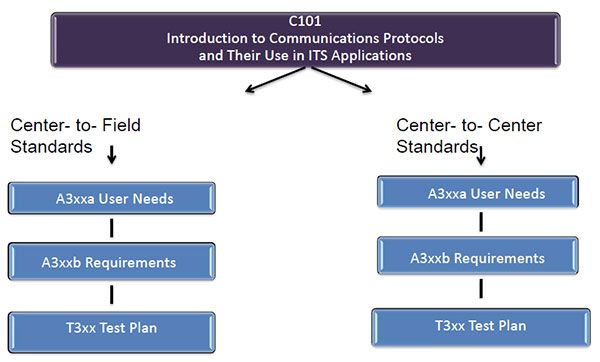
(Extended Text Description: A graphical illustration showing a top box labeled “C101 Introduction to Communications Protocols and Their Use in ITS Applications.” From this top box, two arrows point to two titles of identical three-element vertical arrays, the left one labeled “Center-to-Field Standards” and the right one labeled “Center-to-Center Standards.” The top boxes are labeled “A3xxa User Needs,” the middle boxes are labeled “A3xxb Requirements,” and the bottom boxes are labeled “T3xx Test Plan.”
Slide 9:
Learning Objectives
- Be familiar with the basic terminology of the communications process used in NTCIP.
- Explain how the NTCIP Framework (Stack) fulfills functional requirements to meet operational needs.
- Describe Center-to-Field (C2F) applications and their related NTCIP Standards.
- Describe Center-to-Center (C2C) applications and their related NTCIP Standards.
Slide 10:
Learning Objective #1 — Be familiar with the basic terminology of the communications process used in NTCIP
- What is a protocol? What is a standard?
-
Communications Process
- Open Systems Interconnect-Reference Model (OSI-RM) from the International Standards Organization ( ISO)
- National Transportation Communications for ITS Protocol ( NTCIP) Framework
Slide 11:
Learning Objective #1
Let's Ask Ourselves a Question
"What is the first thing we do when we meet someone?"
Slide 12:
Learning Objective #1
We Observe Some "Protocol"
We greet each other with a hand shake....begin conversation... How are you?

Slide 13:
Learning Objective #1
Computers Observe Protocol

While two computers don't shake hands physically, they do observe some rules—conventions—to begin conversation or communication.
That is what a protocol is about.
Slide 14:
Learning Objective #1
What is a Communications Protocol?
- A protocol is "a set of conventions that govern the interaction of processes, devices, and other components within a system."
Ref. IEEE 610 Std.
Slide 15:
Learning Objective #1
Example
- A protocol is "a specific set of handshaking rules, procedures, and conventions defining the format, sequence, and timing of data transmission between devices that must be accepted and used to understand each other." Source: NTCIP 1203 DMS standard
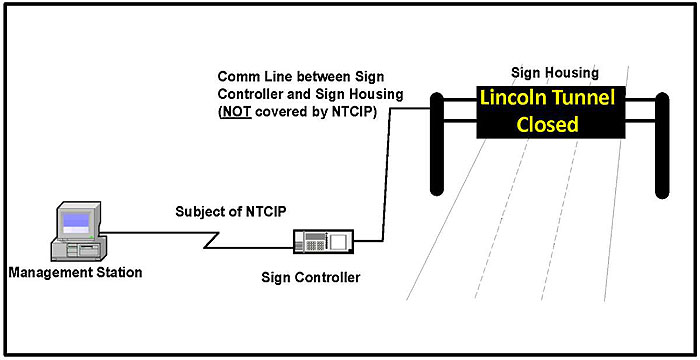
(Extended Text Description: A graphic shows a text box that reads “Central Management Station”. This box is connected to a box on right labeled as “Sign Controller”. From this sign controller box, an arrow connects to overhead gentry–sign housing with a message displayed as “Lincoln Tunnel Closed”. Together this graphical example explains how a central management station can display a message on a sign located in the field and control it remotely. )
Slide 16:
Learning Objective #1
Parts of a Communications Protocol
- Syntax is the data and data format rules; these form the Protocol Data Unit (PDU).
- Semantics are the transfer rules for PDUs. They contain control information-error handling rules.
- Timing deals with performance requirements for the transfer.
Slide 17:
Learning Objective #1
What is a Standard?
A standard defines the rules for the exchanges of the data and establishes a format and mandatory definition for the data elements and sequences of exchanges. The standard will include both mandatory (normative) requirements and optional (informative) information to assist in using the standard.
Slide 18:
Learning Objective #1
Example of a Standard:
Manual on Uniform Traffic Control Devices (MUTCD)
"When a sign is used to indicate that traffic is always required to stop, a STOP (R1-1) shall be used."
"The STOP sign shall be an octagon with a white legend and border on a red background."
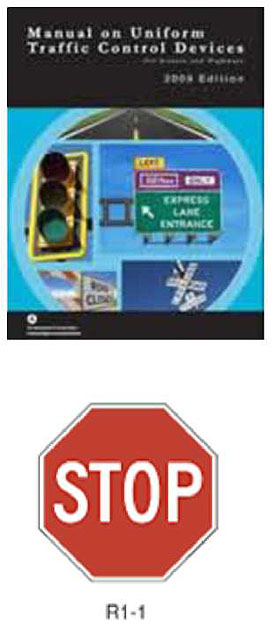
(Extended Text Description: There are two separate graphics:. The first one shows a title cover page of Manual on Uniform Traffic control Devices (MUTCD). The background is in light blue and the cover page shows a three head traffic signal and an overhead sign with gentry. A second separate graphic underneath the MUTCD tile page show a red background octagonal STOP sign known as R1-1. )
Source: FHWA
Slide 19:
Learning Objective #1
ITS Standards
Deal with Data (Information) Structures and Communications, and some ITS Hardware
Benefits
- Developed to assist in obtaining interoperable systems
- Lead to an open procurement process that reduces costs and allows a multi-vendor environment
- Define the interface design details
- Reduce work for the systems manager
- Contribute to the connected transportation environment, our national agenda
Slide 20:
Learning Objective #1
Communications Protocol and Compatibility
"Compatibility is the ability of two or more systems or components to perform their required functions while sharing the same hardware or software environment."
Ref. IEEE 610 Std.
When both ends use the same communications protocols they achieve compatibility.

Slide 21:
Learning Objective #1
Illustration
Compatibility

(Extended Text Description: The slide shows a photo of a computer workstation on the left corner. A two way arrow is shown as a communication channel that connects to the work station. A traffic signal head connects vertically to the arrow as Original equipment. Next to the traffic signal, a vertical combination of traffic controller, camera and a sign is attached as second source equipment. The graphic illustrates that compatibility is achieved when different devices share a communication channel, in this case original traffic signal and newly added equipment. )
Slide 22:
Learning Objective #1
How to Achieve Interoperability?
- Interoperability is the ability of two or more systems or components to exchange information and to use the information that has been exchanged.
Ref. IEEE 610 Std.
- When both ends have compatibility (use the same protocols) and use the same message definitions for the information level, they achieve interoperability.

Slide 23:
Learning Objective #1
Interchangeability
- Same functional and physical characteristics so as to be equivalent in performance and durability
- Ability to exchange devices of the same type without alteration to the device or adjoining items
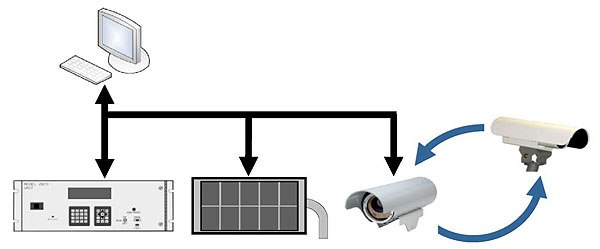
(Extended Text Description: A computer clip art is connected to a two way arrow as a communication channel. A graphic of a traffic controller, sign and a camera hangs off the channel. Two separate curved arrows are shown to replace the original camera with a different camera. The graphic conveys that camera can be interchanged or swapped out without losing the original device’s functionality. )
Slide 24:
Learning Objective #1
What is a dialog?
- Humans and computers both exchange information in orderly conversations called dialogs.
- Dialogs are a sequence of exchanges (messages) that are carried out for a specific purpose.

Slide 25:
Learning Objective #1
Benefits of a Common Protocol
Procurement through Multiple Vendors-Cost Savings
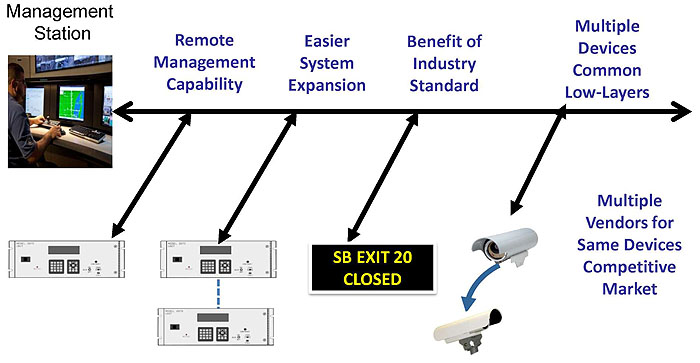
(Extended Text Description: The slide graphic begins with a photo of a computer workstation on the left corner. A two way arrow is shown as a communication channel that connects to the work station. The first benefit shown is labeled as “Remote Management Capability” with a graphic of a traffic signal. The second graphic is with two traffic controllers reads “Easier System Expansion” and demonstrates second benefit. The third graphic shows a sign to convey a benefit of industry standard. The last graphic of swapping a camera indicates benefit of multiple vendors for same equipment. Last text box states “Multiple Devices Common Low-Layers”. )
Slide 26:
Learning Objective #1
What is a Communications Process?
- A communications process handles transmission of data or information between Point A and Point B, involves systems and/or devices, and requires protocols.
- A communications process requires two entities: a common communication medium and a common protocol and common language.

Slide 27:
Learning Objective #1
Open Systems Interconnection (OSI) Reference Model (RM)
Structured Approach: Each Layer Performs a Specific Function with an Assigned Protocol
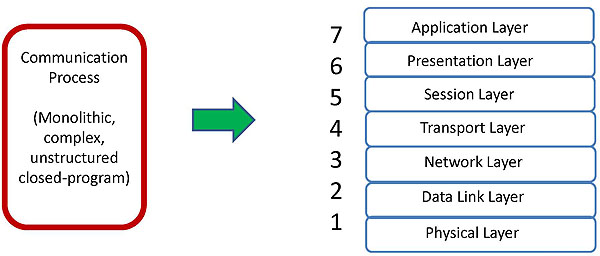
(Extended Text Description: The slide has two text boxes with one way arrow in between pointing from left to right. A text box on the left side of the slide shows a closed communication process with the text "Communication Process (Monolithic, complex, unstructured closed-program). A seven layer box with names is shown on the right. The bottom Physical Layer is labeled as 1 and topmost Application Layer is 7. From bottom to top, the layers are: 1 Physical Layer, 2 Data Link Layer, 3 Network Layer, 4 Transport Layer, 5 Session Layer, 6 Presentation Layer, 7 Application Layer.)
Slide 28:
Learning Objective #1
Understanding the Logical Structure of the OSI-RM
Upper three layers provide application services-user requirements.
Intermediate transport layer separates or masks upper and lower layers.
Lower three layers provide end-to-end-network services.
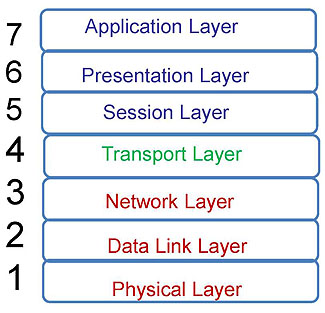
(Extended Text Description: A seven layer stack is shown on the right of the slide. Layer 7, 6, and 5 are grouped together with aligned text on the left-“Upper layers provide application services-user requirements”. The middle layer (4) is Transport layer. The bottom three layers (1, 2 and 3) are called “Lower layers provide end-to-end-network services”. From bottom to top, the layers are: 1 Physical Layer, 2 Data Link Layer, 3 Network Layer, 4 Transport Layer, 5 Session Layer, 6 Presentation Layer, 7 Application Layer.)
Slide 29:
Learning Objective #1
NTCIP Framework

(Extended Text Description: Relevant description from author's notes: NTCIP Framework: A graphic of the communication levels of the NTCIP standards. The bottom level is the Plant Level and includes boxes for Dial-up, Fiber, Coax, Wireless, Twisted Pair, and Leased Line. The next higher level is called the Subnetwork Level and includes PPP, Ethernet, and PMPP. The next level is called the Transport Level and includes TCP/IP, UDP/IP, and T2/NULL. The next level is called the Application Level and includes C2C XML, DATEX, FTP, TFTP, SNMP, and STMP. The next level is called the Information Level and includes C2C Messages, Files, Data Objects, and Dynamic Objects. These boxes are connected to an overarching box also in the Information Level labeled Functional Area Data Dictionaries with the left hand side identifying C2C Data Dictionaries and the right hand side labeled NTCIP Data Dictionaries. )
Note: At each level, there are profile standards to choose from. A profile standard is a collection of standards. (23xx, 22xx, and 21xx are profile standards.)
Slide 30:
Learning Objective #1
Information Level
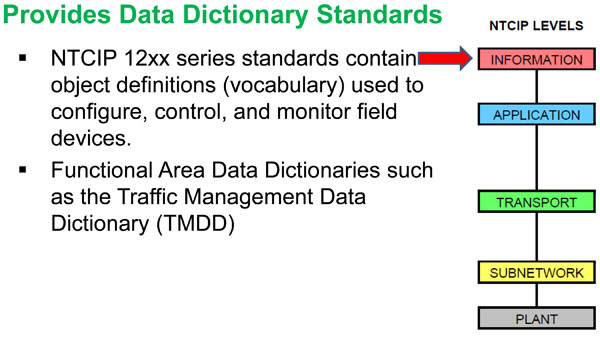
(Extended Text Description: The slide contains the following text and a stack of five vertical text boxes connected to each other on the right:
Provides Data Dictionary Standards
- NTCIP 12xx series standards contain object definitions (vocabulary) used to configure, control, and monitor field devices.
- Functional Area Data Dictionaries such as the Traffic Management Data Dictionary (TMDD)
This slide shows five vertical test boxes connected with each other. The first box is Information Level, followed by Application Level, followed by Transport Level, followed by Subnetwork Level and final one is Plant Level. A straight arrow from the first bullet on slide points to Information level box on right. )
Slide 31:
Learning Objective #1
Application Level
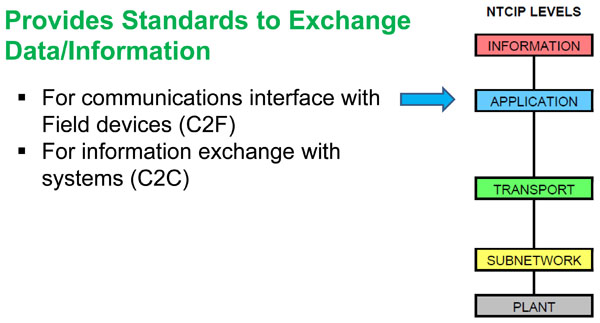
(Extended Text Description: The slide contains the following text and a stack of five vertical text boxes connected to each other on the right:
Provides Standards to Exchange Data/Information
- For communications interface with Field devices (C2F)
- For information exchange with systems (C2C)
The five vertical boxes on the right are the same as Slide 30, except the arrow from first bullet points to Application level box on right. )
Slide 32:
Learning Objective #1
Transport Level

(Extended Text Description: The slide contains the following text and a stack of five vertical text boxes connected to each other on the right:
Provides Transport Protocols
- For connection-based transport service with TCP/IP
- For connection-less transport service with UDP/IP
- For non-routable (direct) transport service for low speed legacy situation with T2/NULL
The five vertical boxes on the right are the same as Slide 30, except the arrow from first bullet points to Transport Level box on right. )
Slide 33:
Learning Objective #1
Subnetwork Level
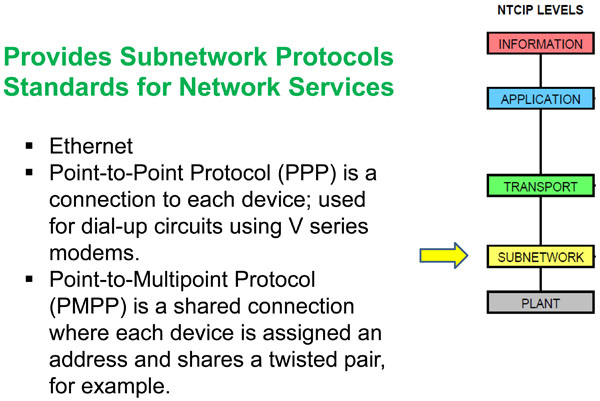
(Extended Text Description: The slide contains the following text and a stack of five vertical text boxes connected to each other on the right:
Provides Subnetwork Protocols Standards for Network Services
- Ethernet
- Point-to-Point Protocol (PPP) is a connection to each device; used for dial-up circuits using V series modems.
- Point-to-Multipoint Protocol (PMPP) is a shared connection where each device i s assigned an address and shares a twisted pair, for example.
The five vertical boxes on the right are the same as Slide 30, except the arrow from first bullet points to Subnetwork Level box on right. )
Slide 34:
Learning Objective #1
Plant Level
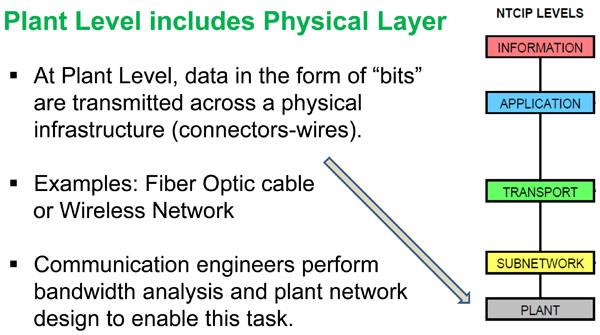
(Extended Text Description: The slide contains the following text and a stack of five vertical text boxes connected to each other on the right:
Plant Level includes Physical Layer
- At Plant Level, data in the form of "bits" are transmitted across a physical infrastructure (connectors-wires).
- Examples: Fiber Optic cable or Wireless Network
- Communication engineers perform bandwidth analysis and plant network design to enable this task.
The five vertical boxes on the right on the right are the same as Slide 30, except the arrow from first bullet points to Plant level box on right. )
Slide 35:
Learning Objective #1
Illustration-1
Communications Process for C2F Dialogs

(Extended Text Description: Relevant description from author's notes: The slide shows two photos: one on the left shows a TMC operator with the series of wall mounted video displays shown in the background. The photo on the right show an operational dynamic messages sign on a gentry in the field with a displayed message: “All crossings to new York closed”. Both photos are connected with C2F text and details underneath. Detail text shows three text boxes: Information level NTCIP 1203 DMS. Application Level SMNP and Transport Level protocol. This slide conveys how a TMC uses standards to conduct the C2F communications process. )
Slide 36:
Learning Objective #1
Illustration-2
Communications Processes for C2C Dialogs

(Extended Text Description: Relevant description from author's notes: This slide shows the same TMC operation photo in above slide 34, and has a photo of another operational TMC on the right. Between the two photos is a C2C standard shown as: Information Level TMDD standard, Application Level NTCIP 2306 XML Profile, and Transport Level TCP/IP standard. This slide conveys how TMCs conduct a C2C communication process with C2C standards. )
Note: A Profile Standard is a Combination of Standards. NTCIP 2304 DATEX is also a C2C Profile.
Slide 37:

Slide 38:
Learning Objective #1
C2F Device Data Standards are Located at:
Answer Choices
- Information Level
- Application Level
- Transport Level
- Subnetwork Level
Slide 39:
Learning Objective #1
Review of Answers
 a) Information Level
a) Information Level
Correct, because Information Level does provide C2F device data standards.
 b) Application Level
b) Application Level
Incorrect, because C2F data standards define data only, while the Application Level houses only the protocols.
 c) Transport Level
c) Transport Level
Incorrect, because Transport Level protocols are used for data transfer and they are not device data standards.
 d) Subnetwork Level
d) Subnetwork Level
Incorrect, because Subnetwork Level protocols are used for sharing a communication channel and they are not device data standards.
Slide 40:
Summary of Learning Objective #1
Be familiar with the basic terminology of the communications process used in the NTCIP.
-
Discussed the communication process
- What is protocol? What is standard?
- Compatibility is achieved with the use of the same communications protocols.
- Interoperability is achieved when systems are compatible and use the same dictionaries, dialogs, and protocols.
Slide 41:
Summary of Learning Objective #1 (cont.)
Be familiar with the basic terminology of the communications process used in the NTCIP.
- Reviewed the seven layer OSI-RM
- Reviewed five levels of the NTCIP Framework and the tasks they perform
Slide 42:
Learning Objective #2 — Explain how the NTCIP Framework (Stack) fulfills functional requirements to meet operational needs.
- What problem is NTCIP addressing?
- Organization of information level dictionaries
- Configuring, controlling, and monitoring of field devices (C2F-master/slave model)
- Information exchange among centers (C2C, peer-to-peer communication)
Slide 43:
Learning Objective #2
What Problem is NTCIP Addressing?
Inability to communicate between different vendors' devices or share a communication channel
- Proprietary vendor-specific devices' functionality
- Closed protocols for communications, which leads to sole source procurement and proprietary systems—more expensive future expansion and integration
Slide 44:
Learning Objective #2
Solution Offered by the NTCIP Framework
-
Interoperability and vendor independence with:
- Common data format for definitions
- Open communications standards
Slide 45:
Learning Objective #2
NTCIP-Based Device Data Standards
Devices from multiple-vendors can share a communication channel.
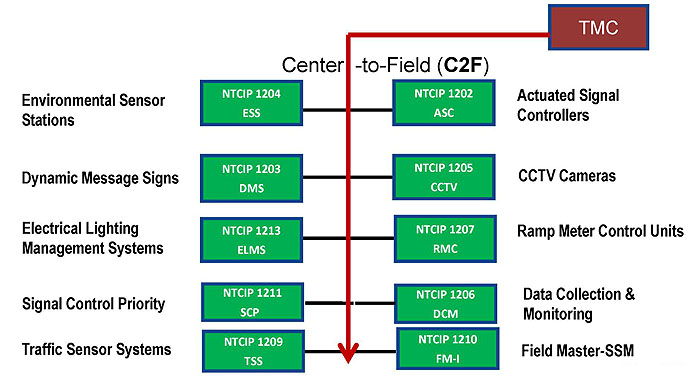
(Extended Text Description: Relevant description from author's notes: NTCIP-Based Device Data Standards: The slide shows 11 square boxes: One on top right corner is marked TMC and is shaded in RED. From the TMC box is a downward arrow is shown in RED. The arrow’s either side is a series of square boxes that lists device data standards. The left side standard begins with Environmental Sensor station and ends in Traffic sensor systems at bottom box. The right side standards begin with Actuated Signal controllers and ends in Field Master-SSM. Each square is shaded green and has NTCP 12xx number. This slide thus serves as an inventory list with NTCIP 12xx numbers. )
Slide 46:
Learning Objective #2
Data Dictionaries
Information Level: NTCIP 12xx
- Device dictionary contains objects that represent functions—features of a device.
- A3xx series training modules cover details on objects and their structure and communication interface.
Slide 47:
Learning Objective #2
What is an Object?
"A data structure used to monitor or control one feature, attribute, or controllable aspect of a manageable device" -NTCIP Standards
- Objects are structured with Abstract Syntax Notation One (ASN.1) Language.

Slide 48:
Learning Objective #2
Management Information Base (MIB)
- MIB is a human readable file format that contains objects designed for configuring, controlling, and monitoring a specific device.

(Extended Text Description: Relevant description from author's notes: The graphic has a rectangular box that contains three bubbles or elliptical circles marked as Object 1, Object 2 and last one Object 70, from which a one way ends into a CCTV MIB cylindrical container. Next to it is image of CCTV camera. Together this layout conveys that 70 objects make up a CCTV MIB used for Camera. )
Illustration: CCTV MIB contains over 70 objects.
Slide 49:
Learning Objective #2
Protocol/MIB Relationship

(Extended Text Description: The slide shows three text boxes: First is marked “MIB provides objects with values”, second “SNMP operations manipulate values of objects” and last “Behavior of the device function altered”. There is an arrow from the first box to next and from second to third box. This shows how they are related to each other. )
Slide 50:
Learning Objective #2
Information Level C2C Data Dictionaries
-
SEP based:
- TMDD contains messages, data elements, and dialogs to support exchanges between traffic management systems.
-
Non-SEP based:
- IEEE 1512 Emergency Management standards contain only data elements and may not deliver interoperable systems consistently (without dialogs).
- Other examples are ATIS and TCIP message standards. (See student supplement for references.)
Slide 51:
Learning Objective #2
Traffic Management Data Dictionary (TMDD)
Supports C2C System Interface Design
- Provides user needs and requirements related to traffic management applications
- Provides data elements, data frames, messages, and dialogs for system interface design
- Local project selects capabilities that are needed from the standard.
Slide 52:
Learning Objective #2
Other Functional Area C2C Dictionaries
- Emergency Management Messages (IEEE 1512)
- Advanced Traveler Information System (ATIS); Data Dictionary (J2353), Messages Sets (SAE J2354)
- Transit Communications Interface Profiles (TCIP) Applications (APTA Standards)
See Participant Student Supplement for where to find these standards.
Slide 53:
Learning Objective #2
How to Combine a Set of Standards for C2F?
Create a Stack by Selecting a Protocol at Each Level
- Data Dictionary for the Device - NTCIP 12xx
- Protocol to Exchange Data - NTCIP 23xx
- Transport Protocol - NTCIP 22xx
- Subnet Protocol - NTCIP 21xx
- Communication Plant - Fiber or....
Slide 54:
Learning Objective #2
Example of DMS Deployment Stack
DMS Dialogs can be carried out with this Stack.

(Extended Text Description: Relevant description from author's notes: The slide is the same as Slide 35, but has a list of specific standards pointing to C2F in the middle, with their numbers, including NTCIP 1203 DMS, NTCIP 2301 SNMP, NTCIP 2202 UDP/IP, NTCIP 2103 PPP.)
Slide 55:
Learning Objective #2
How to Combine a Set of Standards for C2C?
Create a Stack by Selecting a Protocol at Each Level
Example: Traffic Management
- Functional Area Data Dictionary - TMDD
- Application Profile - NTCIP 2306 XML
- Transport - NTCIP 2201 TCP/IP
- Subnetwork - NTCIP 2 104 Ethernet
- Web - Connectivity
Slide 56:
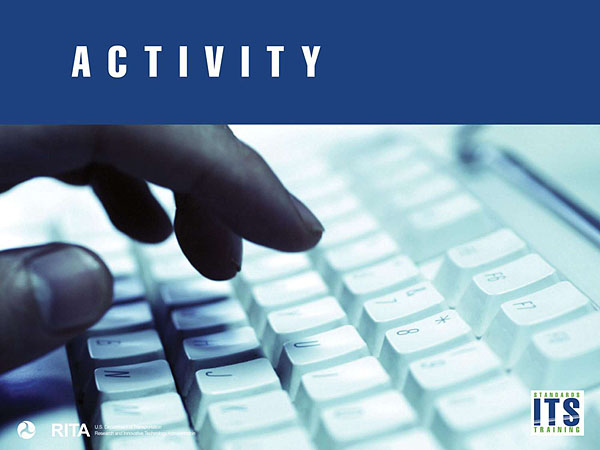
Slide 57:
Learning Objective #2
NTCIP 12xx Device Standards Provide:
Answer Choices
- Management Information Base (MIB) for each field device
- Application protocols such as Simple Network Management Protocol (SNMP) and Simple Transportation Management Protocol (STMP)
Slide 58:
Learning Objective #2
Review of answers
 a) Management Information Base (MIB) for each field device
a) Management Information Base (MIB) for each field device
Correct, because NTCIP 12xx series standards provide a device-specific MIB.
 b) Application protocols such as SNMP and STMP
b) Application protocols such as SNMP and STMP
Incorrect, because application level protocols are covered by NTCIP 23xx series standards.
Slide 59:
Summary of Learning Objective #2
Explain how the NTCIP Framework (Stack) fulfills functional requirements to meet operational needs.
- Discussed problem being addressed by the NTCIP Framework
- Discussed how Information Level NTCIP 12xx series device data dictionaries provide objects to meet C2F operational needs
- Discussed how domain-specific dictionary provides data concepts to support C2C operational needs
Slide 60:
Learning Objective #3 — Describe Center-to-Field (C2F) applications and their elated NTCIP Standards
Operational Needs
- Define SNMP Network Management Model
- Structure of SNMP Messages (Get/Get Next, SET, and TRAP), PDU format
- STMP, FTP, TFTP
Slide 61:
Learning Objective #3
Operational Needs
C2F Standards Supports Management Stationfor:
- Configuring a device (parameters)
- Monitoring a device and gathering data
- Controlling device functions or actions
-
Retrieving logged/events reports when something "unexpected" happens
(Exception reporting by agent)
Slide 62:
Learning Objective #3
C2F Protocols
Protocols Available for Managing Field Devices:
- Simple Network Management Protocol (SNMP)
- Simple Transportation Management Protocol (STMP)
- File Transfer Protocol (FTP)
- Trivial File Transfer Protocol (TFTP)
Slide 63:
Learning Objective #3
Simple Network Management Protocol
(SNMP)
- A C2F communications protocol that is simple and flexible
-
Used in network management to monitor and control devices remotely:
- Manages network devices such as routers, bridges, firewalls, switches, etc.
- Manages ITS devices such as traffic controllers and Dynamic Message Signs (DMS)
Slide 64:
Learning Objective #3
SNMP Network Management Model
Provides Capability for Remote Management

(Extended Text Description: Relevant description from author's notes: The slide conveys SNMP capability for remote management, by showing two components: on Left Management Station and on right Managed Device. Under the Management Station, three small boxes are shown: Management application, MIB and SNMP Manager. The right side shows Managed Device under which SNMP Agent, MIB and Managed Information are shown. A red solid line connects SNMP Manager on left to SNMP Agent on right. )
Slide 65:
Learning Objective #3
Key Components of a SNMP Model
- SNMP Manager: an application program that contacts a SNMP agent to query or modify the database at the agent
- SNMP Agent: a software that runs on a device and maintains information about configuration and current state of database
- MIB: describes the information about the device being managed
Slide 66:
Learning Objective #3
SNMP Operations
- Retrieving the value of the management information accessible by an agent [Read-GET operation]
- Modifying the value of the management information accessible by an agent [Write-SET operation]
- Reporting an event or condition by the agent to the manager [Trap operation in the Internet space, but NTCIP does not support this capability at this time]
Slide 67:
Learning Objective #3
SNMP Messages
Request Messages (Retrieval/Modification operations)
- GetRequest message [give me information on..]
- GetNextRequest message [get more information from the MIB.....get next piece of information]
- SetRequest message [do this action for me on..]
Response Messages (Retrieval operations)
- GetResponse message [here is the information]
Slide 68:
Learning Objective #3
Exception Reporting
-
Two ways to report conditions within NTCIP
- Event logs
- Traps (Future)
- Event logs allow user-defined events to be logged with a timestamp for later retrieval using GetRequest.
- Traps allow these events to be reported immediately to the management station, but this mechanism is not yet standardized by NTCIP.
Slide 69:

Slide 70:
Learning Objective #3
To gather data from a detector station, the central SNMP Manager initiates:
Answer Choices
- GetRequest message
- SetRequest message
- Trap message
- GetResponse message
Slide 71:
Learning Objective #3
Review of Answers
 a) GetRequest message
a) GetRequest message
Correct, because GetRequest retrieves values from the agent of the detector station.
 b) SetRequest message
b) SetRequest message
Incorrect, because SetRequest message is for modifying a value.
 c) Trap message
c) Trap message
Incorrect, because Trap message does not apply; it is not issued by the SNMP manager.
 d) GetResponse message
d) GetResponse message
Incorrect, because GetResponse message only returns a value requested by GetRequest message._
Slide 72:
Learning Objective #3
Simple Transportation Management
Protocol (STMP)
- A variation of SNMP, designed to work with 13 specially designed "dynamic objects."
- Any device could use STMP, but it was only adopted by ASC devices because it allowed the more efficient use of the bandwidth for the real-time retrieval of status information.
Slide 73:
Learning Objective #3
Simple Transportation Management Protocol (STMP) (cont.)
- It has been used in wireless networks and Ethernet to allow multiple objects to be packed into a single block and retrieved with a single GET operation.
- Refer to NTCIP Guide 9001 v04, NTCIP 2301, and NTCIP 1103 v02 for more information.
Slide 74:
Learning Objective #3
File Transfer Protocol (FTP)
- FTP (NTCIP 2303) is a TCP/IP-based Protocol.
-
Examples:
C2F: Environmental Sensor Stations (ESS) standard uses FTP to visually inspect weather conditions and/or verify the reported weather conditions by retrieving camera snapshots.
C2C: FTP is used in the XML- DIRECT.
Slide 75:
Learning Objective #3
Trivial File Transfer Protocol (TFTP)
- TFTP (NTCIP 2302) works with UDP/IP (User Datagram Protocol-connectionless).
- Efficient protocol for transfer of small files
Slide 76:
Learning Objective #3
Illustration
- TMC requests to retrieve the current status of a DMS.
- Agent responds with a value.

(Extended Text Description: Relevant description from author's notes: The slide has a photo of a TMC with operator, and connects to a field DMS device on right. On the right side, DMS controller box is shown with Agent in it. TMC is connected with one arrow to Agent with Request message and another arrow from the agent to TMC with response message. The DMS sign in box reads DMS Message and it is connected to DMS controller. Together this slide conveys that a TMC makes requests the status of the DMS to the agent which then sends a response with a value back to the TMC. )
- Central system translates the response for the user who interprets the response and makes decision on the next step.
Slide 77:

Slide 78:
Learning Objective #3
Which of the following is a preferred protocol for monitoring a DMS?
Answer Choices
- SNMP
- FTP
- STMP
- NTCIP 2306 XML
Slide 79:
Learning Objective #3
Review of answers
 a) SNMP
a) SNMP
Correct, because SNMP is typically used by convention to interface with the DMS in the field.
 b) FTP
b) FTP
Incorrect, because FTP is only used for file transfer.
 c) STMP
c) STMP
Incorrect, because STMP can be used only in ASC applications and by convention it is not typically used for DMS or other devices.
 d) NTCIP 2306 XML
d) NTCIP 2306 XML
Incorrect, because NTCIP 2306 XML is a profile standard used in C2C applications.
Slide 80:
Summary of Learning Objective #3
Describe Center-to-Field (C2F) applications and their related NTCIP Standards
- Reviewed operational support provided by the C2F standards: configuration, monitoring, and control.
- Discussed protocols used in the C2F applications and focused on the SNMP model and services it provides.
Slide 81:
Learning Objective #4 — Describe Center-to-Center (C2C) applications and their elated NTCIP Standards
- Center-to-Center (C2C) Operational Needs
- Communications System Interface
- TMDD Data Concepts
- Components of NTCIP 2306 XML Profile
- Messaging models used in NTCIP 2306 XML
Slide 82:
Learning Objective #4
C2C Terminology
- W3C - World Wide Web Consortium
-
XML - eXtensible Markup Language
Encoding method for messages -
WSDL - Web Services Description Language
Center's Public Interface Format -
SOAP - Simple Object Access Protocol
Communication method for XML Messages -
HTTP - Hypertext Transfer Protocol
Web browser Transport Protocol - PRL - Profile Requirements List (in NTCIP 2306)
NTCIP 2304 DATEX Application Profile Standard
NTCIP 2306 XML Application Profile Standard
Slide 83:
Learning Objective #4
Operational Needs (C2C)
System Interface Supports Information Exchange
- Need to Share Event Information
- Need to Provide Control of Devices, Share Status, and Data
- Need to Provide Roadway Network Data
- Need to Share Data for Archiving

Slide 84:
Learning Objective #4
Types of Generic Dialogs (TMDD)
Dialogs are a logical sequences of messages put together to conduct a "conversation" between centers.
- Request/Response - Information Sharing
- Subscription - Information Updates
- Publication - Published Information
Slide 85:
Learning Objective #4
NTCIP 2306 XML Application Profile
-
TMDD Supplies:
-
Data Concepts in XML Format
- Dialogs, messages' data-frames, and data-elements
-
Data Concepts in XML Format
- NTCIP 1104 Naming Conventions
-
NTCIP 2306 Supplies:
- XML Schema-WSDL-SOAP
- Transport: HTTP or XML
- TCP/IP
Slide 86:
Learning Objective #4
Introduction to Web Service
- A web service is any service (operation equivalent to functions) that is available over the Internet/Intranet.
- Uses a standardized XML messaging system
- Independent of operating systems or programming languages
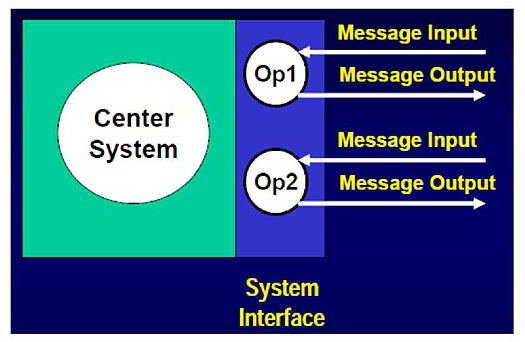
(Extended Text Description: Relevant description from author's notes: The figure show a big rectangul in which a circle is shown marked as Center System. This circle is separated by a solid line. Next are two small circles each marked as OP1 and OP2. Both have one way arrow coming in as Message Input and one way arrow going out as Message Output. Underneath the two OP circle is System Interface. This conveys that the operations performed by system interface use messages. )
Slide 87:
Learning Objective #4
SOAP (Simple Object Access Protocol)
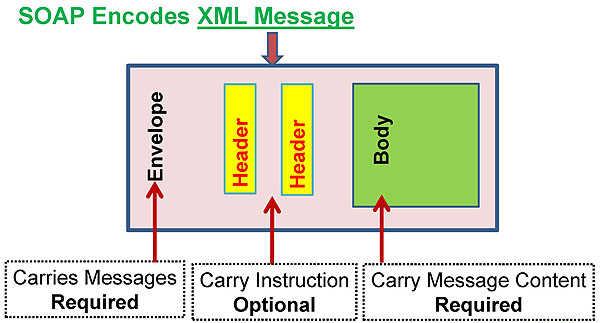
(Extended Text Description: Relevant description from author's notes: The slide has a graphic entitled "SOAP Encodes XML Message," that shows a rectangular shape in which four vertical rectangles are shown: first is marked Envelope, second and third are marked Header and last one a Body. Underneath are boxes with the text "Carries Messages Required" pointing to Envelope, "Carry Instruction Optional" pointing to Header boxes, and "Carry Message Content Required" pointing to Body. The slide conveys three parts of SOAP message. )
Slide 88:
Learning Objective #4
NTCIP 2306 Implementation
- Project specification needs are listed in a conformance statement.
- Profile Requirements List (PRL) allows user to state selected sub-profile options (ref. NTCIP 2306 standard).
Table 3 Profile Requirements to Solution Trace (Profile Requirements List)
Profile Requirements List (PRL) |
NTCIP 2306 v01 Section |
Mandatory / Optional |
Profile Requirement |
Project Requirement |
|
|---|---|---|---|---|---|
1.0 |
SOAP over HTTP |
||||
a) WSDL Request-Response |
O |
||||
- WSDL General |
6.1 |
M |
|||
- Definitions |
6.2 |
M |
PR 3.1 |
||
- Types/Schema |
6.3 |
M |
PR 3.1, 3.2 |
||
Slide 89:

Slide 90:
Learning Objective #4
Which of the following is NOT applicable to C2C?
Answer Choices
- NTCIP 2306 XML
- SNMP
- SOAP
- WSDL
Slide 91:
Learning Objective #4
Review of Answers
 a) NTCIP 2306 XML
a) NTCIP 2306 XML
Incorrect, because NTCIP 2306 XML is applicable to C2C as a profile standard.
 b) SNMP
b) SNMP
Correct, because SNMP applies to C2F only.
 c) SOAP
c) SOAP
Incorrect, because SOAP is the transport protocol used in NTCIP 2306 XML.
 d) WSDL
d) WSDL
Incorrect, because WSDL is used in C2C as a language standard.
Slide 92:
Summary of Learning Objective #4
Describe Center-to-Center (C2C) applications and their related NTCIP Standards
- Reviewed C2C Operational Needs
- Discussed C2C System Interface (SI)
- Discussed Generic Dialogs in TMDD
- Introduced NTCIP 2306 XML Profile
- Introduced Web service, SOAP, and WSDL
Slide 93:
What We Have Learned
- We have learned that the NTCIP Family of standards are based on the ISO's OSI-RM
- Two categories of the N CIP communications standards are C2F and C2C .
- NTCIP objects are based on th ASN.1 anguage representation, which is an ISO standard.
- NTCIP 12xx series device data standards are located at the Information Level
Slide 94:
What We Have Learned (cont.)
- SNMP s used for remote management of ITS devices located in the field.
- Specifically, SNMP performs Retrieval and Modification operations to manage a field device.
- C2C standards used in the traffic management applications include the TMDD and NTCIP 2306 XML
Slide 95:
Resources
- Participant student supplement provides a list of references.
- NTCIP 9001 v04 Guide, NTCIP C2F and C2C Standards documents are available in the NTCIP library at www.ntcip.org
- TMDD Standard v03 and TMDD v02 Guide are available at www.ite.org.
Slide 96:

Slide 97:
Additional Communications Modules
C201: Introduction to Simple Network Management Protocol (SNMP) and its Applications in the Field Devices Based on NTCIP Standards
C202: Introduction to the Application Level Protocols for Center-to-Center Communications System Interface Implementation (NTCIP 2306 XML)